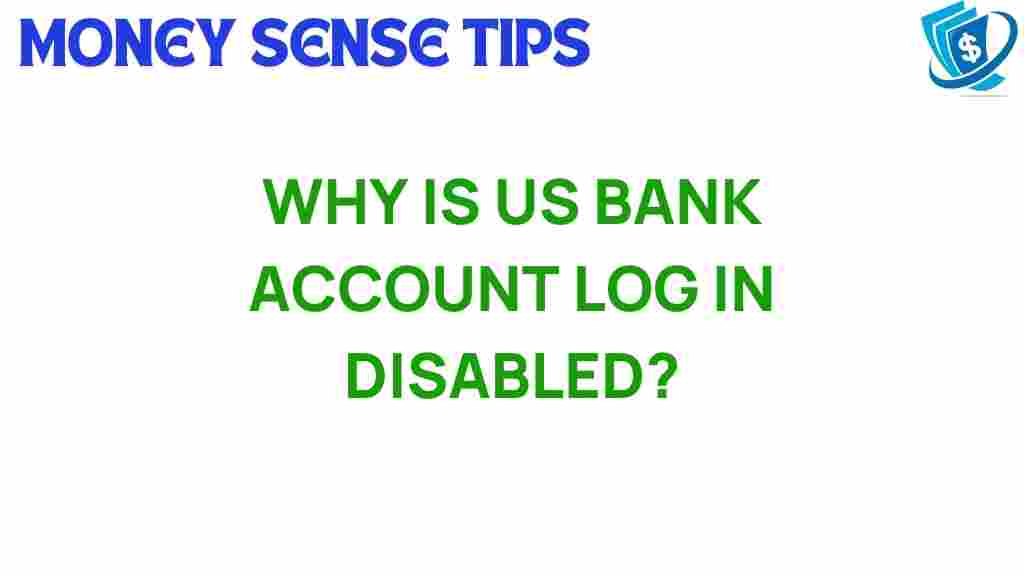The Mystery Behind Disabled U.S. Bank Account Logins Revealed
Online banking has revolutionized the way we manage our finances, making it easier than ever to access our accounts from anywhere in the world. However, many U.S. bank account holders experience login issues that can be frustrating and concerning. Understanding the reasons behind these problems is crucial for maintaining bank security and ensuring a smooth user experience. In this article, we will explore common login issues, how to troubleshoot them, and how customer service can assist you in regaining access to your account.
Understanding U.S. Bank Account Login Issues
Login issues can arise for various reasons. Here are some of the most common factors that can lead to a disabled U.S. bank account login:
- Incorrect Credentials: The most frequent cause of login issues is entering the wrong username or password. This can happen due to typos or simply forgetting your credentials.
- Account Lockout: After several failed login attempts, your account may be temporarily locked for security reasons. This is a protective measure to prevent unauthorized access.
- Security Alerts: If the bank detects unusual activity on your account, it may disable your login as a precautionary measure.
- Technical Glitches: Sometimes, server issues or maintenance can cause temporary login problems.
- Browser Compatibility: Using an outdated browser or one that is not supported by the bank’s online platform can lead to access issues.
Importance of Bank Security
Bank security is paramount in protecting your financial information. U.S. banks implement various measures to ensure the safety of your account, including:
- Two-Factor Authentication: Many banks require an additional verification method, such as a code sent to your mobile device, to enhance security.
- Encrypted Connections: Secure Socket Layer (SSL) encryption is used to protect your data during online transactions.
- Monitoring for Fraud: Banks actively monitor accounts for suspicious activity and will often take preemptive measures if something seems amiss.
While these security measures are designed to protect you, they can also lead to login issues if they trigger an alert or lockout. Understanding this balance between security and user experience is key to navigating any problems that arise.
Steps to Troubleshoot U.S. Bank Account Login Issues
If you find yourself locked out of your U.S. bank account, don’t panic. Follow these steps to troubleshoot your login issues:
1. Verify Your Credentials
Double-check your username and password. Ensure there are no typos and that you are using the correct case (upper/lower). If you have forgotten your password, follow the bank’s password recovery process.
2. Check for Account Lockout
After multiple failed attempts, your account may be locked. Most banks will inform you of this on the login page. Wait a few minutes or hours as the lockout may be temporary.
3. Clear Browser Cache and Cookies
Sometimes, outdated cookies or cache can cause login issues. Clear your browser’s cache and cookies and then try logging in again.
4. Try a Different Browser or Device
If you’re using an outdated browser or experiencing issues on your current device, try accessing your account from a different browser or device.
5. Disable Browser Extensions
Extensions, particularly those related to privacy or ad-blocking, can interfere with online banking. Temporarily disable these extensions and see if you can log in.
6. Check Bank’s Website Status
Occasionally, banks perform maintenance or experience technical difficulties. Check the bank’s official website or social media for any announcements regarding outages.
Contacting Customer Service
If you’ve tried all troubleshooting steps and still can’t access your U.S. bank account, it’s time to contact customer service. Here’s how you can prepare for that call:
- Gather Information: Before calling, have your account information, identification, and any error messages ready to provide to the representative.
- Explain the Issue Clearly: Describe the steps you’ve already taken to resolve the issue. This can help the representative assist you more efficiently.
- Ask About Security Measures: Inquire whether any security alerts have been triggered on your account and what steps you can take to resolve them.
Customer service is there to help you regain access to your account and can provide insights into any specific issues affecting your login capabilities.
Enhancing Your Online Banking Experience
To avoid future login issues and enhance your overall online banking experience, consider implementing the following best practices:
- Use Strong Passwords: Create a unique and complex password that includes a mix of letters, numbers, and symbols.
- Regularly Update Credentials: Change your password periodically to further enhance security.
- Enable Notifications: Sign up for account alerts to monitor any suspicious activities or changes made to your account.
- Keep Software Updated: Regularly update your browser and device software to ensure compatibility and security.
Conclusion
Login issues for U.S. bank accounts can be frustrating, but understanding the common causes and troubleshooting methods can help you regain access quickly. Always prioritize bank security while navigating online banking. If you encounter persistent problems, don’t hesitate to reach out to customer service for assistance. By following the best practices outlined in this article, you can enhance your user experience and enjoy the convenience of online banking without the hassle of login issues.
For more information on bank security measures, visit this resource. If you need further assistance, check out this helpful guide on troubleshooting online banking issues.
This article is in the category Services and created by MoneySenseTips Team
